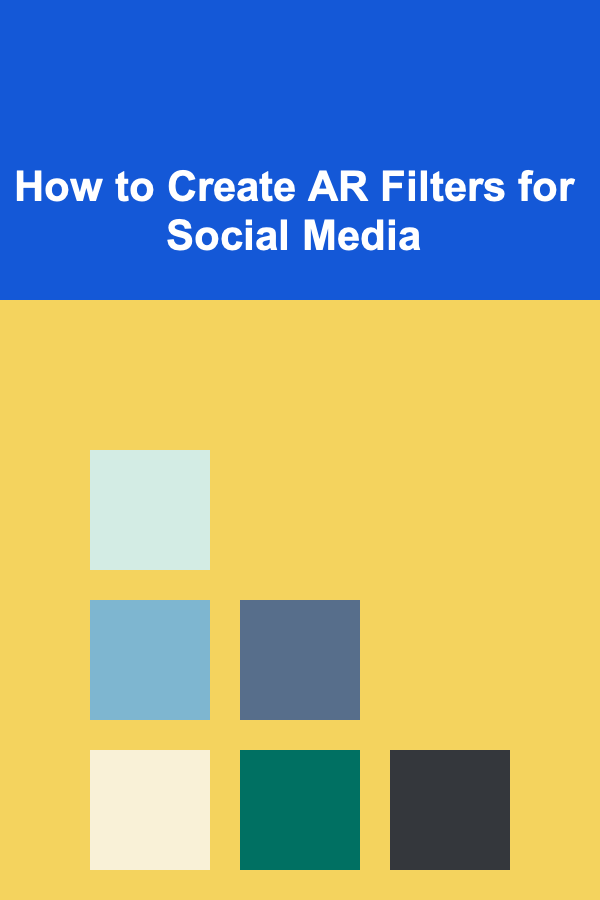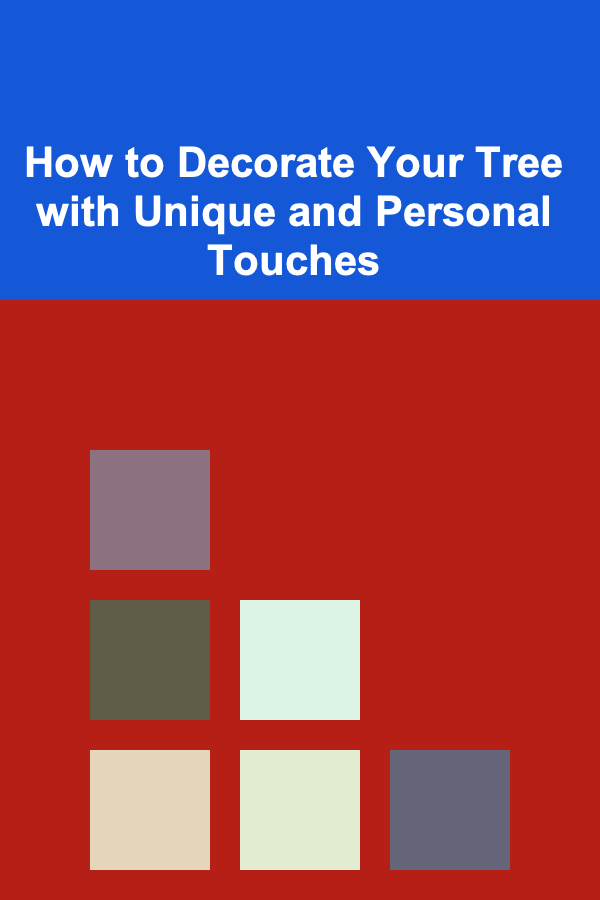
How to Create AR Filters for Social Media
ebook include PDF & Audio bundle (Micro Guide)
$12.99$9.99
Limited Time Offer! Order within the next:

Augmented Reality (AR) filters have become one of the most exciting and engaging features of modern social media platforms. Whether it's Snapchat, Instagram, or Facebook, AR filters offer an interactive way to enhance users' photos and videos. These filters, which blend digital elements with the real world, have captured the imaginations of millions, allowing people to transform their selfies, alter environments, and even add special effects in real time.
Creating AR filters for social media can be an incredibly rewarding endeavor, whether you're a digital artist, a marketer, or a social media influencer looking to make your mark. But what does it take to create these filters? In this guide, we'll take a deep dive into the process of creating AR filters for social media, covering everything from the basic concepts to the tools, techniques, and best practices to make your filter stand out.
What are AR Filters?
Before diving into the creation process, it's important to understand what AR filters are. AR filters are digital overlays that can be applied to the real world via a screen. These filters typically use the camera of a mobile device or computer to capture real-world imagery, then superimpose graphics, animations, and other elements over that scene.
In the context of social media, these filters are used to modify images or videos in fun, creative ways. Some popular examples include:
- Face Filters: Alters your facial features, such as adding virtual makeup, changing facial expressions, or even transforming you into different characters.
- Background Filters: Replaces or enhances the background of your image or video with digital elements, often used in selfies.
- Interactive Filters: These filters respond to the user's movements or gestures, such as changing color or shape when you blink or move your head.
By enhancing images and videos, AR filters can create an engaging experience for users, whether they're looking to entertain their audience, promote a product, or experiment with creative effects.
Why Create AR Filters for Social Media?
There are numerous reasons to get involved in creating AR filters for social media. Some of the most compelling reasons include:
1. Engagement and Reach
AR filters can dramatically increase engagement on social media. By giving users something fun and creative to interact with, filters can encourage them to share their photos and videos. This creates a viral effect that can extend your reach and visibility.
2. Brand Awareness
For businesses and influencers, AR filters are an excellent way to promote a brand or product in a fun and interactive way. Custom filters with branded elements can generate organic buzz and help spread awareness across social media platforms.
3. Creative Expression
Creating AR filters allows you to push the boundaries of creativity. You can design unique effects, animations, and 3D models, making it an exciting medium for self-expression. Whether you're an artist or a developer, creating filters can be an outlet for your creative abilities.
4. User Experience Innovation
AR filters offer users an innovative experience. People enjoy experimenting with new ways to represent themselves, especially when they are able to personalize their content through dynamic, interactive elements.
Tools for Creating AR Filters
Creating AR filters typically requires specialized software and development tools. These tools allow you to design and implement your filters, ensuring they function seamlessly on social media platforms. Here's a rundown of the most popular tools for creating AR filters:
1. Spark AR Studio (Facebook/Instagram)
Spark AR Studio is one of the most popular platforms for creating AR filters, especially for Facebook and Instagram. It offers a wide range of features, such as the ability to add 3D objects, animations, and face-tracking capabilities. Spark AR Studio also allows for real-time testing and previewing, making it easier to tweak your filter during development.
Key Features:
- Face Tracking: Create filters that track the user's face, adding effects like makeup, hats, or animated features.
- 3D Object Placement: Position 3D models in the real world through the camera feed.
- Patch Editor: Allows you to create interactive effects by connecting different modules.
- Real-time Testing: Test filters on your device or through the Spark AR Player app.
Getting Started:
To use Spark AR Studio, you need to download the program on your computer. From there, you can create new projects, import 3D models, and script interactions using JavaScript. Spark AR Studio provides an intuitive drag-and-drop interface, making it relatively easy for beginners to get started.
2. Lens Studio (Snapchat)
Snapchat's Lens Studio is a robust tool designed for creating filters (or lenses) for Snapchat. Lens Studio provides a wide array of pre-built templates and features to help you get started. It also supports advanced functionality such as 3D tracking, hand gestures, and face animations.
Key Features:
- Face and Body Tracking: Lens Studio has powerful tracking tools for both faces and bodies, enabling you to create effects that follow the user's movements.
- World Effects: Apply effects to the environment around the user, such as adding virtual objects to real-world scenes.
- Interactive Lenses: Lenses that respond to user actions, like tapping or swiping.
Getting Started:
Lens Studio can be downloaded directly from Snapchat's website. It comes with an extensive library of templates, so you can start by modifying existing lenses or create new ones from scratch using a visual scripting tool or by coding with JavaScript.
3. Adobe Aero (Cross-Platform)
Adobe Aero is another powerful AR design tool that enables you to create interactive AR experiences. While it is more commonly used for immersive AR experiences, it can also be used to create filters for social media platforms like Instagram and Facebook, particularly when paired with other Adobe tools like Photoshop and Illustrator.
Key Features:
- Drag-and-Drop Interface: Intuitive interface that allows you to place and animate 3D objects easily.
- Multi-Platform Support: Allows you to publish to different platforms, including social media and AR devices.
- Integration with Adobe Creative Cloud: Seamlessly integrate assets created in Photoshop, Illustrator, or After Effects.
Getting Started:
Adobe Aero requires a Creative Cloud subscription. Once installed, you can begin creating AR filters and experiences with its user-friendly interface, even without prior coding experience.
Step-by-Step Guide: How to Create Your First AR Filter
Creating an AR filter for social media involves several key steps. While the specifics may vary depending on the platform and tool you use, the general process remains largely the same. Let's break down the steps for creating an AR filter using Spark AR Studio as an example:
1. Conceptualize Your Filter
Before you start creating, think about the purpose and design of your AR filter. Ask yourself:
- What effect do you want to create? (e.g., face filter, environment filter, or interactive effect)
- What will make the filter unique or engaging for users?
- Is there a brand or theme you want to incorporate?
Sketching out your ideas beforehand can help you stay focused and organize your design.
2. Set Up Spark AR Studio
- Download and install Spark AR Studio on your computer.
- Open Spark AR Studio and create a new project.
- Choose a template if you're a beginner or start from scratch for full creative control.
3. Create or Import Assets
Depending on the type of filter you're making, you might need to create or import 3D models, textures, or animations. For example:
- Face Filter: Create textures or 3D models (like glasses or hats) to place on the user's face.
- Background Filter: Import images or 3D models to replace the background.
- Interactive Effects: Script interactions based on the user's actions, like blinking or moving their head.
You can create assets in other programs like Blender or Photoshop, and then import them into Spark AR Studio.
4. Apply Tracking
If you're creating a face or body filter, use the Face Tracker or Body Tracker in Spark AR Studio to attach your digital assets to the user's face or body. You can also use Plane Trackers for environment-based filters.
5. Add Interactivity
Using Spark AR's Patch Editor or JavaScript, you can program interactions within your filter. For example, you could make a 3D object rotate when the user moves their head, or change colors when they blink.
6. Test Your Filter
Once your filter is designed, you can test it using the Spark AR Player app. This lets you see how your filter looks on a real device and make adjustments as needed.
7. Publish Your Filter
After testing, you're ready to publish. Spark AR Studio allows you to submit your filter to Facebook and Instagram directly from the platform. Once approved, your filter will be available for others to use.
Best Practices for AR Filters
Creating AR filters isn't just about having fun with design; it's also important to consider how users will experience the filter. Here are some best practices to keep in mind:
1. Keep It Simple
While it's tempting to pack in as many effects and features as possible, simplicity often leads to better user experiences. A clean, easy-to-use filter will attract more users and encourage them to share it.
2. Consider Mobile Performance
AR filters can be resource-intensive, so make sure your filter is optimized for mobile performance. Test it on different devices to ensure it runs smoothly, even on lower-end smartphones.
3. Make It Interactive
The best filters are those that engage users in some way. Consider adding interactive elements, such as gestures, animations, or triggers based on the user's actions.
4. Stay On-Brand
If you're creating a filter for a business or influencer, ensure that the design aligns with the brand's visual identity and messaging. This will help strengthen brand recognition.
Conclusion
Creating AR filters for social media is an exciting and rewarding process that allows you to push the boundaries of creativity while engaging with a large audience. Whether you're an artist, marketer, or developer, mastering the tools and techniques for creating AR filters can be a game-changer in your digital content creation journey.
By using platforms like Spark AR Studio, Lens Studio, and Adobe Aero, you can design interactive, fun, and visually captivating filters that will engage users and enhance their social media experience. As AR technology continues to evolve, the possibilities for creating innovative and immersive experiences are endless.

How to Decorate Your Tree with Unique and Personal Touches
Read More
How to Make the Most of Your Home Insurance for Maximum Savings
Read More
How to Maximize the Appeal of Your Rental Property for Showings
Read More
How to Repair and Maintain Your Home's Fencing
Read More
How to Use DIY Solutions to Soundproof Your Home on a Budget
Read More
How to Get Started with Freelance Income
Read MoreOther Products

How to Decorate Your Tree with Unique and Personal Touches
Read More
How to Make the Most of Your Home Insurance for Maximum Savings
Read More
How to Maximize the Appeal of Your Rental Property for Showings
Read More
How to Repair and Maintain Your Home's Fencing
Read More
How to Use DIY Solutions to Soundproof Your Home on a Budget
Read More